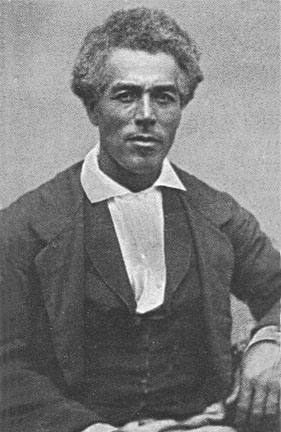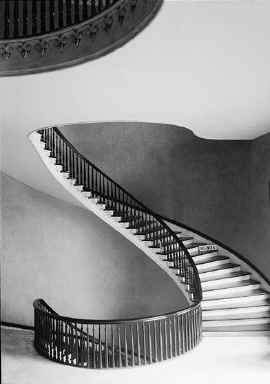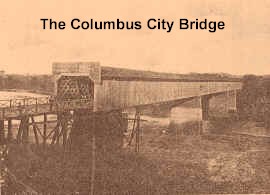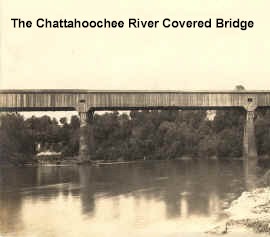|
From Slave to Bridge Builder
Covered wooden bridges have long captivated the
American imagination. More than quaint relics of horse and buggy days,
these remarkable achievements in civil engineering helped forge the
physical and economic growth of the United States for over a century. By
the 1870s, more than 10,000 covered bridges spanned the American
landscape. Today, roughly 750 remain, with the majority located in
Pennsylvania, Ohio, Vermont, Indiana, New Hampshire, and Oregon.
 Horace
King was a successful bridge architect and builder in west Georgia,
northern Alabama and northeast Georgia in the period between the 1830s
and 1870s. He was born a slave on September 8, 1807 in Chesterfield
District, South Carolina. King's ancestry was a mix
of African, European, and Catawba Indian. Taught to read
and write at an early age, he had become a proficient carpenter and
mechanic by his teenage years. Records indicate King spent his first 23
years near his birthplace, with his first introduction to bridge
construction in 1824. In 1824, bridge architect Ithiel Town came to
Cheraw, South Carolina to assist in the construction of a bridge over
the Pee Dee River. While it is unknown whether King assisted in the
construction of this bridge or its replacement span built in 1828,
Town's lattice truss design used in both Pee Dee bridges became a
hallmark of King's future work. When King's master died around 1830,
King was sold to John Godwin, a contractor who also worked on the Pee
Dee Bridge. King may have been related to the family of Godwin's wife,
Ann Wright. In 1832, Godwin received a contract to construct a 560-foot
bridge across the Chattahoochee River from Columbus, Georgia to Girard,
Alabama, today Phenix City. Godwin an King moved from Columbus to Girard
in 1833. The pair began many other construction projects, including
house building. They built Godwin’s house first, then King’s. King
and Godwin built nearly every early house in Girard. Horace
King was a successful bridge architect and builder in west Georgia,
northern Alabama and northeast Georgia in the period between the 1830s
and 1870s. He was born a slave on September 8, 1807 in Chesterfield
District, South Carolina. King's ancestry was a mix
of African, European, and Catawba Indian. Taught to read
and write at an early age, he had become a proficient carpenter and
mechanic by his teenage years. Records indicate King spent his first 23
years near his birthplace, with his first introduction to bridge
construction in 1824. In 1824, bridge architect Ithiel Town came to
Cheraw, South Carolina to assist in the construction of a bridge over
the Pee Dee River. While it is unknown whether King assisted in the
construction of this bridge or its replacement span built in 1828,
Town's lattice truss design used in both Pee Dee bridges became a
hallmark of King's future work. When King's master died around 1830,
King was sold to John Godwin, a contractor who also worked on the Pee
Dee Bridge. King may have been related to the family of Godwin's wife,
Ann Wright. In 1832, Godwin received a contract to construct a 560-foot
bridge across the Chattahoochee River from Columbus, Georgia to Girard,
Alabama, today Phenix City. Godwin an King moved from Columbus to Girard
in 1833. The pair began many other construction projects, including
house building. They built Godwin’s house first, then King’s. King
and Godwin built nearly every early house in Girard.
The two then went on to build the courthouses of
Muscogee County, Georgia and Russell County, Alabama and bridges in West
Point, Georgia, Eufaula, Alabama and Florence, Georgia. They built a
replacement for their Columbus City Bridge between Columbus and Girard
in 1841, because the original was destroyed by a flood in 1838. Godwin
issued five-year warranties on his bridges because of his confidence in
King’s high quality work.
The Columbus City Bridge was the first known bridge
to be built by King, who likely planned the construction of the bridge
and managed the slave laborers who built the span. King worked for his
master, John Godwin who owned a successful construction business. It is
thought by scholars that Godwin sent King to Oberlin College in Ohio,
the first college in the United States to admit African-American
students, in the mid-1830s. Although King was a slave, Godwin treated
him as a valued employee and eventually gave him considerable influence
over his business. Horace King supervised many of Godwin's business
activities including the management of construction sites.
In 1837, during a time of financial difficulty,
Godwin transferred ownership of King to his wife and her uncle, William
Carney Wright of Montgomery, Alabama. This may have been done to protect
King from being taken and sold by Godwin's creditors. King was allowed
to marry Frances Gould Thomas, a free woman of color, in April 1839. It
was extremely uncommon for slave owners to allow such marriages, since
Frances' free status meant that their children would all be born free.
The couple had four boys and one girl. The King
children eventually joined their father at working on various
construction projects. In addition to building bridges, King constructed
homes and government buildings for Godwin's construction company.
 By
1840, King was being publicly acknowledged as being a co-builder along
with Godwin, an uncommon honor for a slave. King's stature had surpassed
that of his master by the early 1840s. He worked independently as
architect and superintendent of major bridge projects in Columbus,
Mississippi and Wetumpka, Alabama. While working on the Chattahoochee
River covered bridge in Eufaula, Alabama, King met Tuscaloosa attorney
and entrepreneur Robert Jemison, Jr., who soon began using King on a
number of different projects in Lowndes County, Mississippi, including
the 420-foot Columbus, Mississippi Bridge. Jemison would remain King's
friend and associate for the rest of his life. King bridged the
Tallapoosa River at Tallassee, Alabama in 1845. Later that same year he
built three small bridges for Jemison near Steens, Mississippi, where
the latter owned several mills. By
1840, King was being publicly acknowledged as being a co-builder along
with Godwin, an uncommon honor for a slave. King's stature had surpassed
that of his master by the early 1840s. He worked independently as
architect and superintendent of major bridge projects in Columbus,
Mississippi and Wetumpka, Alabama. While working on the Chattahoochee
River covered bridge in Eufaula, Alabama, King met Tuscaloosa attorney
and entrepreneur Robert Jemison, Jr., who soon began using King on a
number of different projects in Lowndes County, Mississippi, including
the 420-foot Columbus, Mississippi Bridge. Jemison would remain King's
friend and associate for the rest of his life. King bridged the
Tallapoosa River at Tallassee, Alabama in 1845. Later that same year he
built three small bridges for Jemison near Steens, Mississippi, where
the latter owned several mills.
Despite his enslavement, King was allowed a
significant income from his work and, in 1846, used some of his earnings
to purchase his freedom from the Godwin family and Wright. However,
under Alabama law of the time, a freed slave was only allowed to remain
in the state for a year after being liberated. Jemison, who served in
the Alabama State Senate, arranged for the state legislature to pass a
special law giving King his freedom and exempting him from the
manumission law. In 1852, King used this freedom to purchase land near
his former master. When Godwin died in 1859, King had a monument erected
over his grave.
In 1849, the Alabama State Capitol burned, and King
was hired to construct the framework of the new capitol building, as
well as design and build the twin spiral entry staircases. King used his
knowledge of bridge building to cantilever the stairs' support beams so
that the staircases appeared to float, without any central support.
Around 1855, King formed a partnership with two other
men to construct a bridge, known as Moore's Bridge, over the
Chattahoochee between Newnan and Carrollton, Georgia, near Whitesburg.
Instead of collecting a fee for his work, King took stock instead,
gaining a one-third interest in the bridge. King moved his wife and
children to the bridge about 1858, although he continued to commute
between it and their other home in Alabama. Frances King and their
children collected the bridge tolls and farmed at Moore's Bridge. The
earnings from Moore's Bridge allowed King a steady income, though he
continued to design and construct major bridge projects through the
remainder of the 1850s, including a major bridge in Milledgeville,
Georgia and a second Chattahoochee crossing in Columbus, Georgia.
During the Civil War, King continued to work on
construction projects usually for the Confederacy including a building
for the Confederate navy near Columbus, Georgia. Confederate officials
also forced King to block several waterways to prevent Union access to
strategic points in Georgia and Alabama.
Many of King’s bridges were destroyed by Union
troops including Moore’s Bridge in July 1864. When Union soldiers
attacked Columbus, Georgia in April 1865, they burnt all of King’s
bridges in that city, including the one he had finished less than two
years earlier.
 The
destruction of the war led to new opportunities for King. Within six
months after the war's end, King and a partner had constructed a
32,000-square-foot cotton warehouse in Columbus and King had, for the
third time rebuilt the original Columbus City Bridge. Over the next
three years, King would construct three more bridges across the
Chattahoochee in Columbus, a major bridge in West Point, Georgia, two
large factories, and the Lee County, Alabama courthouse. The
destruction of the war led to new opportunities for King. Within six
months after the war's end, King and a partner had constructed a
32,000-square-foot cotton warehouse in Columbus and King had, for the
third time rebuilt the original Columbus City Bridge. Over the next
three years, King would construct three more bridges across the
Chattahoochee in Columbus, a major bridge in West Point, Georgia, two
large factories, and the Lee County, Alabama courthouse.
In October 1864, his wife died leaving King a widower
with five surviving children to care for. He remarried, immediately
after the Civil War ended to Sarah Jane Jones McManus.
When the Reconstruction Acts were implemented in
1867, King became a registrar for voters in Russell County, Alabama.
Later that year, he attempted to establish a colony of freedmen in
Georgia. While that plan was unsuccessful, King went on to be elected to
the Alabama House of Representatives in 1868 as a Republican
representing Russell County. King, though, busy in his construction
business in Columbus, did not take his seat until over a year later, in
November 1869. King remained a reluctant legislator, voting only 78% of
the time and proposing only three bills, none of which became law.
Despite his inaction, King was reelected in 1870, proposing no bills in
the 1870-71 session and only five in the 1871-72 session, one of which,
a prohibition on the sale of alcohol in Hurtsboro, Alabama, became law.
King did not seek reelection in 1872.
After King left the Alabama Legislature in 1872 he
moved with his family to LaGrange, Georgia. While in LaGrange, King
continued building bridges, but also expanded to include other
construction projects, specifically businesses and schools. By the
mid-1870s, King had begun to pass on his bridge construction activities
to his five children, who formed the King Brothers Bridge Company.
King's health began failing in the 1880s, and he died on May 28, 1885 in
LaGrange.
 King
received flattering obituaries in each of Georgia's major newspapers, a
rarity for African-Americans in the 1880s South. King was posthumously
inducted into the Alabama Engineers Hall of Fame at the University of
Alabama in 1989. The award was accepted on his behalf by his great
grandson, Horace H. King, Jr. King
received flattering obituaries in each of Georgia's major newspapers, a
rarity for African-Americans in the 1880s South. King was posthumously
inducted into the Alabama Engineers Hall of Fame at the University of
Alabama in 1989. The award was accepted on his behalf by his great
grandson, Horace H. King, Jr.
For more than a century the achievements of King have
been well known in the Lower Chattahoochee River Valley. Local writers
and chambers of commerce proudly proclaim their Horace King bridges or
buildings even when there is little or no real historical evidence to
verify many of the claims.
In 2004 the Horace King Overlook, a deck attached to
the historic Bridge House at RiverFront Park in Albany, Georgia, was
dedicated in King's honor. The overlook's structure includes a miniature
replica of one of King's covered bridges. King is remembered for both
his engineering skill and for his character. |